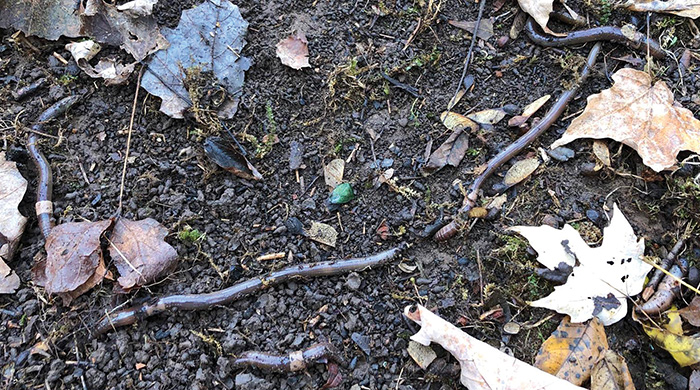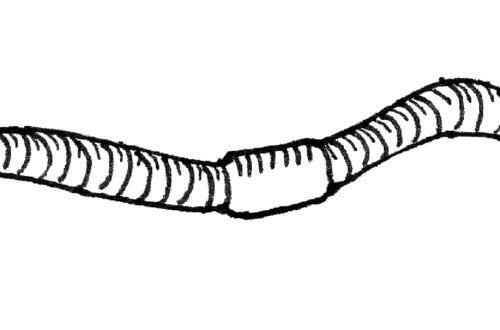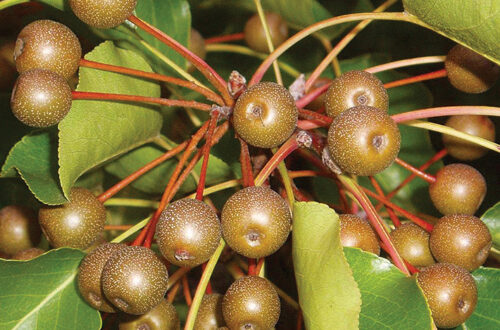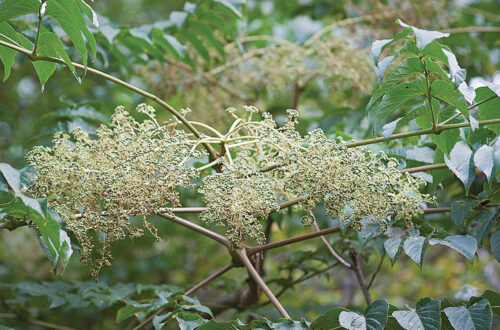By Annise Dobson
Many of us have grown up thinking that earthworms are a sign of healthy, fertile soil. Recently, a bigger, faster, and incredibly abundant earthworm has been showing up in Connecticut farms, gardens, and forests.
Earthworms can be beneficial in their native ecosystems and agricultural settings, but their ability to re-engineer soil can completely restructure ecosystems and the microbial, plant, arthropod and vertebrate communities that live within them.
Native Earthworms in Connecticut
While its true that most earthworms you will encounter are non-native,
we have a small number of native earthworm species in Connecticut. The
last glaciation is thought to have pushed earthworms out of Connecticut, but Dr. Tim McCay at Colgate University and colleagues have been identifying populations of native species in the region, including Bimastos parvus, B. tumidus, Eisenoides lonnbergi, and Sparganophilus eiseni.
Unlike invasive European and jumping worms, these native earthworm species are mainly associated with streams, ponds, lakes, wetlands, springs, or saturated soils. McCay and colleagues hypothesize that these connected watersheds may be the easiest routes of re-colonization after the glacier receded, so the water-loving species are the only ones to have made it back in 10,000 years.
Alternatively, these wet habitats could be refuges to escape competition from invasive species that dominate in upland forests. These earthworms play a very different role in the ecosystem, living in wetlands as opposed to upland forests, existing in comparatively low abundances, and modifying soils much less than the much more common invasive species. Even though they are quite different, managing invasive earthworms becomes complicated with native earthworm species in the mix!
Invasive Earthworms in Connecticut
Ecological communities in Connecticut evolved largely in the absence of earthworms for the past ~10,000 years. Leaf decomposition by fungi, bacteria and other soil fauna happened slowly, allowing an organic soil horizon (otherwise known as duff or leaf litter) to build up, creating a unique habitat for plants and animals to grow.
With very few exceptions almost every earthworm you will encounter in Connecticut is not native, including the robust nightcrawler, the cheerful composting red wriggler, and the odd green earthworm that never seems to make it off the sidewalk after a storm.
Much of what we know about invasive earthworms comes from studies of these invasive European earthworm species, whose effects on forests are particularly notable in temperate North America.
More recently, jumping worms, (the common name for several similar-looking species belonging to the family Megascolecidae, also known as crazy worms, snake worms, Alabama jumpers, Jersey wigglers, Georgia jumpers, pheretimoids), have invaded temperate and tropical ecosystems across the globe.
The invasive jumping worms found in Connecticut trace their origins to east Asia. In their native range these species are restricted to ditches and disturbed soil, and different earthworm species live in forests. Jumping worm distribution is patchy throughout North America, and while often associated with urban and suburban landscapes, they are appearing with greater frequency in natural areas and forests. Once introduced to a location, jumping worm populations grow rapidly, and can grow to high densities in 4-5 years.
In Connecticut, jumping worms have been on the radar of gardeners, managers, scientists, and landscapers for at least a decade, but our understanding of their distribution is still very incomplete.
By 2015, jumping worms were known to be in two of Connecticut’s eight counties, particularly in the southwest of the state (Reynolds 2015). However, they were thought to be limited to golf courses, greenhouses
and vermi-composting systems.
Jumping worms have certainly expanded their range both across the state and within counties, moving rapidly through suburban and natural areas. At this local scale, spread is mainly through dumping yard waste into natural areas and transporting mulch and soil with jumping worm eggs (sometimes called cocoons) or adults. Both cocoons and adults will disperse with gravity downslope and through waterways.
Jumping worms have also moved throughout the state, reaching high abundances through central and southern Connecticut, but to my knowledge, no exhaustive survey of jumping worms in the state has been performed.
If you think you have seen a jumping worm in Connecticut, please upload your findings onto the iMapInvasives website – imapinvasives.org. We are actively using this information to understand jumping worm movement, which we will use to inform managers and citizens about best practices to prevent their further spread.
Jumping Worm Impacts
Jumping worm invasions are unique in that they consist of multiple co-invading species including Amynthas agrestis, Amynthas tokioensis, and Metaphire hilgendorphi in temperate North America.
Jumping worms grow and mature quickly, and some species can reproduce asexually, thereby quickly reaching high densities from an initially small invading population. They grow and mature much more quickly than European or native earthworms.
While both European and jumping earthworms consume the organic horizon, the texture of jumping worm-invaded soils is even more stressful for roots, fungi and soil fauna. This is because jumping worms transform surface soils into large macroaggregates, described as ‘gravelly,’ with the appearance of ground beef or spent coffee grounds. This is ideal habitat for jumping worms, allowing them to retreat to deep soil that is buffered from temperature extremes or predators. Unfortunately, these changes lead to soil erosion, nutrient leaching, root desiccation, and plant death [see Fig 1 below].
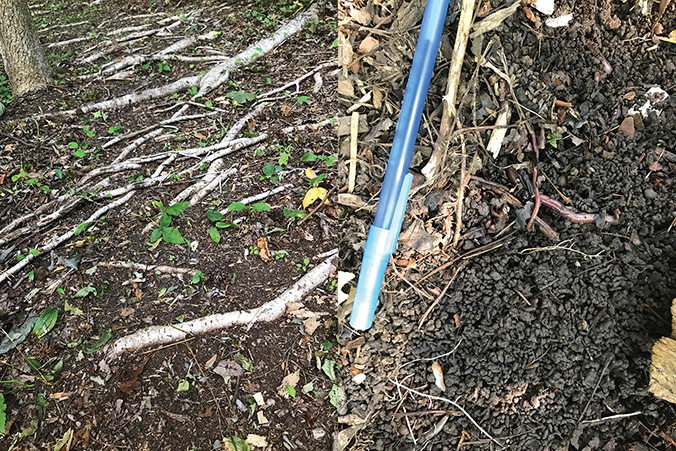
Photos / Annis Dobson
Populations of native plant species that rely on symbiotic fungi to forage for nutrients and water can disappear following a heavy invasion of jumping worms. The dry, loose soil texture is not conducive to fungal hyphae growth, and earthworms consume the fungi.
European earthworms can also consume a staggering amount of seeds, roots, and even full seedlings, and it is certainly possible that jumping worms do the same.
Jumping worms co-occur with invasive plants, but my preliminary research suggests this is not because jumping worms promote invasive plants, but rather invasive plants are the last to disappear. I hypothesize that there are a few plant species with unique adaptations such as Polygonum virginianum (jumpseed) [Persicaria virginiana] that sprouts from a toppled stem and vines (both invasive and native) that are flexible in where they root. Instead of native tree regeneration we will get weedy species, vines, or perhaps no plants at all.
The deep layer of loose castings created by jumping worms is particularly problematic for perennial plants (both native and horticultural), as well as parks and lawns used for recreation.
The cascading effects of jumping worms on other species are far reaching. In areas of heavy infestation, soil fauna, salamanders, and birds that rely on the forest floor for food, habitat, and shelter are impacted.
In addition to habitat loss, jumping worms don’t make great food. They are much less nutritious for songbirds than the other soil fauna that they outcompete. Their huge population fluctuations within and between years can create food shortages for birds.
Jumping worm tissues can accumulate toxic metals, suggesting they could be a major pathway for metal bioaccumulation in higher organisms.
In addition to deteriorating natural systems, jumping worm impacts are being felt by gardeners, plant nurseries, golf courses and community parks.
How to Identify A Jumping Worm Invasion
It is important to be able to recognize the characteristics of a jumping worm invasion. However, the three main invaders in Connecticut are annual species, and are only easy to recognize between July and September. Instead, an invasion can be identified all year round by noting the distinctively granular soil, described as looking like ground beef or spent coffee grounds. If you are looking in summer or early fall, jumping worm presence can be confirmed by observing key features of the earthworms:
• Thrashing behavior and high densities
• Smooth, metallic sheen, often darkly pigmented, and 1.5 to 8 inches long
• Clitellum often cream colored and goes all the way around the body, unlike the lumbricid species which have a raised and pink-colored clitellum.
What You Can Do To Limit Jumping Worm Invasions
Because we currently lack any viable control strategies, efforts should be put on limiting human-mediated dispersal of adults and cocoons. Fortunately, the worms don’t move very quickly on their own! Best practices should include:
• Require clean equipment provisions in logging and landscaping contracts (and encourage your neighbors and local government to do the same
• Heat-treat compost and mulch (130°F for three days is best but 104°F for three days should be sufficient)
• Prevent dumping of yard waste
• Plant bare-root, check for cocoons [see Fig. 2 below]; approximately the size of a slow-release fertilizer pellet)
• Don’t move soil in tools, equipment, shoes
• Don’t dump bait or compost worms
• Don’t use compost and mulch of unknown origin
• Log jumping worm observations with iMapInvasives
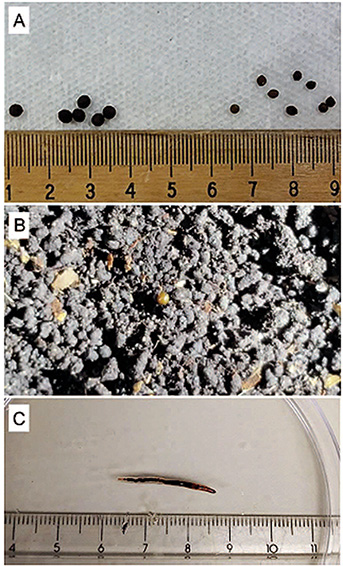
Figure 2. Photographs of (A) Jumping worm cocoons; (B) Cocoon surrounded by jumping worm-modified soil; (C) Juvenile jumping worm visible in spring.
Photos / Marie Johnson, UW Madison Arboretum
For more information see
• https://bit.ly/2UHSyw2
• https://bit.ly/2WJoCSP
• https://bit.ly/3brDDN3
Dr. Dobson is a postdoctoral researcher in the Yale School of Forestry & Environmental Studies. She grew up in Ontario, Canada, and has a PhD from Cornell University. Her research is motivated by forest conservation for all, particularly in urban and managed forests in New York City. Her current focus is on characterizing and mitigating the invasion of Megascolecid earthworms (Jumping worms) in North America. She is seeking to identify their impacts on plant communities including both native and invasive species in the tree understory, and to understand how human activities or landscape features facilitate or prevent invasion. Ultimately, she hopes to develop innovative ecological solutions and management guidelines to mitigate jumping worm spread and impacts.
